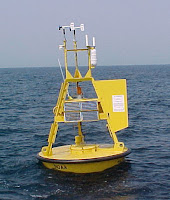Broken Water Pipe Takes Out U.S. Buoy Data
I have gotten a number of emails from folks asking about the lack of U.S. buoy data during the past several days.
They are right...something has happened. A broken pipe and flooding has closed down a key NOAA data facility in Silver Spring, Maryland, and there is no estimate of when this data source will become available. And, in fact, other important data sources are also being affected, such as the coastal marine sites (CMAN) and even some airport locations.
The NOAA National Data Buoy Center page notes the situation:Buoy data over the oceans is a very important weather data source, in support of both numerical weather prediction and marine activities. There are, in fact, two main types of ocean buoys: fixed or moored buoys, which possess a relatively wide range of weather/ocean observations, and drifting buoys that move around the ocean freely (see pictures below).
Fixed buoys:
Drifting buoy:
To give you an idea of the distribution and number of the buoy data, here is an example of the drifting buoy data locations immediately before the water leak (which occurred on March 9). Quite a few!
Now the lack of marine data is not only an issue for weather prediction, but it can be an even larger problem for those involved in marine operations, who use weather data for the management of ports and sea lanes. Thus, the loss of surface marine observations put life and property at risk.
This outage is important because it shows the vulnerability of critical data infrastructure at NOAA, with dependencies on single servers and the lack of backup systems. There are others.
NOAA operations acutely need "hot" backups that can immediately take over when primary servers go down.
This is not only true for the ingestion of observations, but for the critically important weather modeling as well. Cloud-based backups are one way to do this at a reasonable cost. And there is always the old fashion way of maintaining independent servers in different locations.
Whatever approach NOAA takes, creating a more robust data and modeling infrastructure should be a high priority.
I am sure there are folks at Microsoft and Amazon who would be happy to help.😋













Comments
Post a Comment